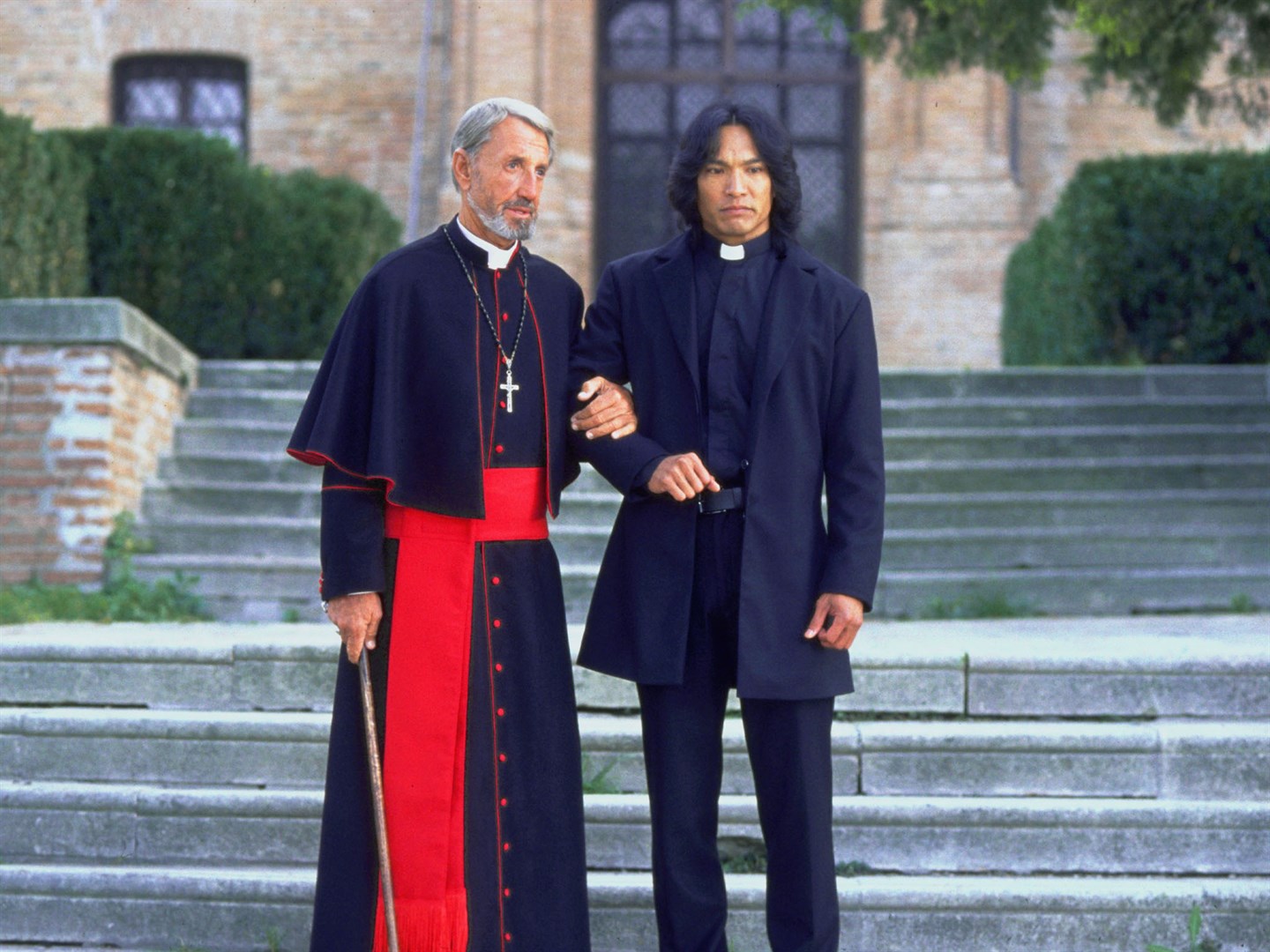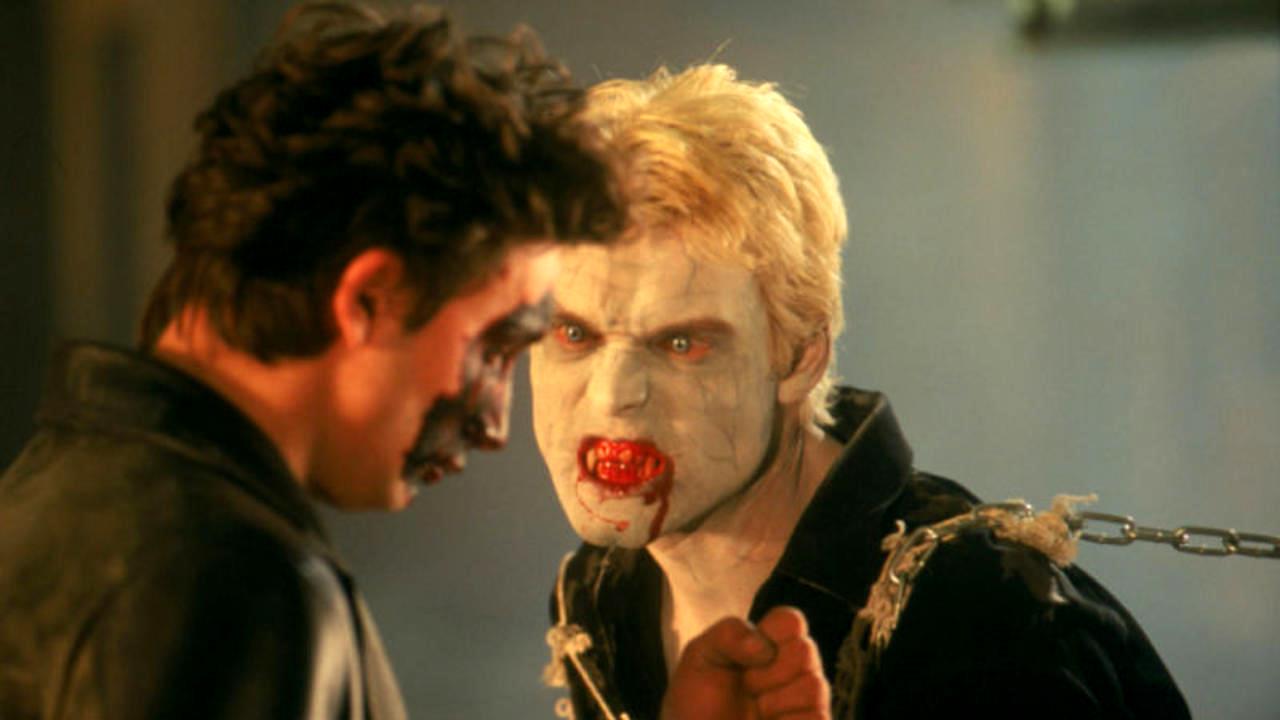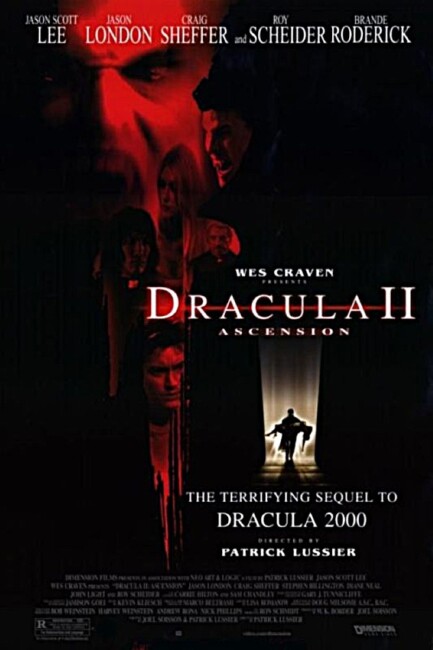USA. 2003.
Crew
Director – Patrick Lussier, Screenplay – Patrick Lussier & Joel Soisson, Producers – W.K. Border & Joel Soisson, Photography – Doug Milsome, Music – Kevin Kliesch, Dracula 2000 Themes – Marco Beltrami, Visual Effects – Neo Digital Imaging (Supervisor – Jamison Goei), Special Effects Supervisor – Lucian Iordache, Makeup Effects – Tunnicliffe/Two Hours in the Dark, Inc. (Supervisor – Gary Tunnicliffe), Production Design – Cristian Niculescu. Production Company – Dimension Films/Neo Art & Logic.
Cast
Jason Scott Lee (Father Uffizi), Diane Neal (Elizabeth), Craig Sheffer (Lowell), Jason London (Luke), Stephen Billington (Dracula II), John Light (Eric), Khary Payton (Kenny), Brande Roderick (Tanya), Roy Scheider (Cardinal Siqueros), Jennifer Kroll (Twins of Evil), John Sharian (Officer Hodge), Daniela Nane (Cat Woman)
Plot
A charred body is brought in to the New Orleans morgue. In examining it, attendants Luke and Elizabeth realise the fantastical truth – that it is a vampire’s body. A mysterious caller then offers Luke $30 million for the body. Instead, they make the decision to steal the body and study it themselves. Elizabeth’s boyfriend Lowell, a medical lecturer who is wheelchair-ridden with cerebral palsy, sets up a makeshift laboratory at an abandoned swimming pool complex. They use blood to revive the vampire and then chain it up under ultraviolet lights. They set out to study its blood with Lowell wanting to find a way to obtain a cure for his condition. The experiment starts to go wrong as members of the study group become infected by the vampire’s blood. Meanwhile, the Catholic priest Father Uffizi comes, hunting the vampire, determined to perform the Last Rites and save its soul.
Dracula II: Ascension was the first of two sequels to the minor success of Dracula 2000 (2000), which revived Dracula in the present-day. It was followed by Dracula III: Legacy (2005). While Dracula 2000 was released theatrically, both Dracula II and Dracula III went directly to video/dvd. All three films were directed by Patrick Lussier, written by Lussier and Joel Soisson, and produced by Soisson and W.K. Border for Dimension Films and Soisson’s Neo Arts & Logic production company.
There are some good ideas behind Dracula II, as there often are in Joel Soisson’s scripts. There is a fine scene between Diane Neal and Jason London in the morgue as the body is brought in and they gradually discover that it is charred to a cinder but has a white liver, that there are fangs hidden behind its teeth and how drops of blood start to revive it. The gradual revelation of a vampire is somewhat undercut by banal dialogue – “See I was right … This can’t be happening … We’ve got something impossible happening here” – nevertheless, the scene has something potentially imaginative to it, as though it is a conceptual mix of a vampire film and CSI: Crime Scene Investigation (2000-15).
This is followed by an equally fascinating series of scenes where they steal the body from the morgue, set up an experiment in an abandoned building and then revive the vampire in a bath of blood. There are some good ideas about Craig Sheffer’s medical researcher wanting to scientifically analyse the vampire’s blood and remove its evil so as to find a cure for his cerebral palsy. There is also a particularly good climactic scene where the vampire stops priest Jason Scott Lee from killing him by tempting him with the knowledge that he knew Jesus Christ personally.

If Dracula II: Ascension had stayed here and taken the route of scientifically exploring the nature of vampirism, rather than tried to be a B horror film, it could have been a highly original treatment. Instead, it feels like a film of potentially good ideas undone by poor direction. The script is reasonably imaginative but Patrick Lussier directs it down at a cheap and schlocky level. Lussier did okay on Dracula 2000 where he had a reasonable budget at his disposal, even if Dracula 2000 became a gimmick and effects-heavy film. Clearly, that budget made the difference and its absence here sinks Lussier. There are some silly pieces such as where Brande Roderick bursts out in her red underwear to attack Jason Scott Lee or where Diane Neal goes to the bathroom and fails to see vampires lurking in the darkness behind her.
There is a reasonably attention grabbing opening scene where it seems as though Jason Scott Lee, all in black, is pursuing a frightened girl (Jennifer Kroll) through the streets of an unnamed European city, where the roles suddenly become reversed and she and a (digitally replicated) twin turn out to be vampires and Lee a Catholic priest, whereupon he captures her using a bullwhip, beheads her and then tosses holy water over the bodies to ignite them.
One of the most irritating aspects of Patrick Lussier’s direction is the depiction of the vampire. The character is constantly surrounded by irritatingly hyped snarls, roars, bangs and its voice is sinisterly underlined on the soundtrack. It is a vampire whose effect exists solely as a theatrical special effect. When we do get past these to Stephen Billington’s performance itself, the character exists as no more than a cardboard threat.

There are also times that Dracula II seems hastily written. The characters do things for hard to believe reasons – Jason London is the one who decides to steal the corpse but then abruptly turns around and spends the rest of the film abhorrent at what they have done; the character of Kenny (Khary Payton) for no particular reason decides to inject vampire blood into himself; while Craig Sheffer has a ridiculous twist motivation about having once discovered a vampire in a morgue before it vanished and then having recruited a host of morgue assistant girlfriends in the improbable hope of one day having another vampire’s corpse cross the threshold.
Craig Sheffer gives a stiff and awkward performance throughout. It is hard to understand why Sheffer felt he could not give a straightforward reading and had to keep twisting himself and his face around. Jason London also gives a twitchy performance as though he was wired on something throughout shooting, while Khary Payton overacts badly.
Jason Scott Lee is the most well-known face and the lead of the show. Lee is an okay actor, although is more used to physical roles in films like Dragon: The Bruce Lee Story (1993), The Jungle Book (1994) and Rapa Nui (1994). It does seems a hard stretch to accept the long-haired Hawaiian-Chinese born Lee as a Catholic priest, not someone more suited to being a warrior.
Patrick Lussier had earlier made his directorial debut on the Joel Soisson produced The Prophecy 3: The Ascent (2000) and would later go onto make the genre likes of White Noise: The Light (2007), My Bloody Valentine (2009), Drive Angry (2011), Trick (2019) and Play Dead (2022), as well as write the script for Terminator Genisys (2015).
Trailer here


